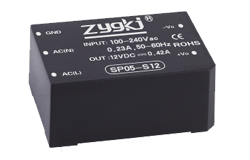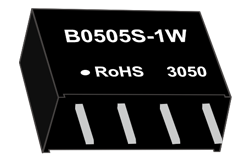خبریں
DC Power Conversion: Understanding the Basics and Best Practices
مصنف: زیڈ وائی جی پاور ماڈیول Time: 2023-6-4
Power conversion is an essential process in modern electronics, enabling devices to operate using different voltage and current levels. In this article, we will take a closer look at DC power conversion, its basics, and best practices.
DC power conversion refers to the process of converting DC voltage levels from one level to another. This process is necessary because different electronic devices operate using different voltage levels. For example, a smartphone may operate using a voltage of 3.7 volts, while a laptop may require a voltage of 19 volts. To ensure that electronic devices can operate efficiently and safely, DC power conversion is used to convert the voltage levels to suit the specific needs of each device.
The process of DC power conversion involves the use of power electronic devices such as diodes, transistors, and capacitors. These devices are used to regulate the voltage and current levels of the DC power, ensuring that the output voltage is the same as the input voltage, or that it is a specific value that is required by the device.
There are two main types of DC power conversion: linear and switching. Linear power conversion is a simple process that involves the use of a voltage regulator to maintain a constant voltage output. This process is highly efficient when the input voltage is close to the desired output voltage. However, when there is a significant difference between the input and output voltage, linear power conversion can result in high power losses, making it an inefficient method.
Switching power conversion, on the other hand, is a more complex process that involves the use of a switching regulator. This method is highly efficient, even when the input voltage is significantly different from the desired output voltage. The switching regulator works by switching the DC input voltage on and off at a high frequency, resulting in a stable output voltage. The switching regulator is highly efficient because it reduces the power loss associated with linear power conversion.
Best Practices for DC Power Conversion
When designing and implementing DC power conversion systems, there are several best practices that engineers should follow to ensure that the system is efficient, reliable, and safe. These best practices include:
1. Use High-Quality Components
The quality of the components used in the power conversion system can significantly impact the performance and reliability of the system. It is essential to use high-quality components that are designed to operate at the required voltage and current levels. Using low-quality components can result in system failure, safety hazards, and reduced efficiency.
2. Use Proper Cooling Techniques
Power conversion systems generate a significant amount of heat, which can impact the performance and reliability of the system. It is essential to use proper cooling techniques, such as heat sinks, fans, or liquid cooling, to ensure that the system operates at a safe temperature.

3. Follow Safety Standards
DC power conversion systems can pose a safety hazard if not designed and implemented correctly. It is essential to follow safety standards and guidelines, such as those set by the International Electrotechnical Commission (IEC), to ensure that the system is safe for use.
4. Test and Monitor the System
To ensure that the DC power conversion system is operating efficiently and reliably, it is essential to test and monitor the system regularly. This includes testing the system under different load conditions, monitoring the temperature of the components, and checking for any abnormal behavior.
نتیجہ
DC power conversion is an essential process in modern electronics, enabling devices to operate using different voltage and current levels. Understanding the basics of DC power conversion and following best practices can help engineers design and implement efficient, reliable, and safe power conversion systems. By using high-quality components, proper cooling techniques, following safety standards, and testing and monitoring the system regularly, engineers can ensure that the DC power conversion system operates at peak performance.
پچھلا: XXYY Series DC DC Converter
اگلے: Shop AC to DC Converters: Convert AC Power to DC with Ease!
متعلقہ معلومات
-
2023-8-2
Efficient AC to DC Converter for LED Lighting with 12V Output
Introduction: In recent years, LED lighting has gained popularity due to its energy efficiency and long lifespan. To power these LED lighting systems, an efficient AC to DC converter is required to convert the alternating current (AC) from the power source to the direct current (DC) needed by the LEDs. This article explores the importance of an efficient AC to DC converter for LED lighting and presents a detailed analysis of a converter with a 12V output. Advantages of LED Lighting: Before delving into the AC to DC converter, it is essential to understand the advantages of using LED lighting. LEDs are renowned for their energy efficiency, consuming significantly less energy compared to traditional incandescent bulbs. Additionally, LEDs have a...
تفصیلات دیکھیں -
2023-5-24
High-Efficiency Industrial AC-DC Converter for Reliable Power Conversion
Abstract: This paper presents the design and implementation of a high-efficiency industrial AC-DC converter for reliable power conversion. The proposed converter is based on a two-stage structure that includes a power factor correction (PFC) stage and a DC-DC stage. The PFC stage is implemented using a boost converter, while the DC-DC stage is implemented using a full-bridge converter. The proposed converter is capable of operating in a wide input voltage range and provides a regulated DC output voltage. Simulation and experimental results show that the proposed converter achieves high efficiency and meets the requirements of industrial applications. Introduction: In industrial applications, reliable power conversion is essential to ensure the stable operation of various equipment and systems. AC-DC converters are widely...
تفصیلات دیکھیں -
2023-9-21
Enhance Your PC Performance with a Modular Power Supply
A modular power supply is a key component in any computer system, responsible for providing stable and efficient power to all the components. Power supply units (PSUs) come in various types, including non-modular, semi-modular, and modular. Among these, a modular power supply is gaining popularity due to its versatility and ability to enhance PC performance. In this article, we will explore the benefits of using a modular power supply and why it is an excellent investment for your computer system. Firstly, let's understand what exactly a modular power supply is. Unlike non-modular PSUs, which have a fixed set of cables permanently attached to the unit, modular PSUs allow users to connect only the cables they need. This means that unnecessary...
تفصیلات دیکھیں -
2023-10-18
In today's technology-driven world, having a reliable and efficient power supply is crucial. Whether you are a gamer, a content creator, or a professional working with heavy-duty applications, having a power supply that meets your power demands is essential. This is where a fully modular 650W power supply comes into play. It offers the perfect solution for efficient and customizable power management. Firstly, let's understand what a fully modular power supply is. Unlike traditional power supplies, where all cables come pre-attached, a fully modular power supply allows users to connect only the cables they need. This eliminates unnecessary cable clutter inside the computer case, improving airflow and reducing heat build-up. With a fully modular power supply, you have the freedom...
تفصیلات دیکھیں -
2023-5-21
Efficient 12V AC to DC Converter for LED Lighting Applications
LED lighting has become increasingly popular due to its energy efficiency, long lifespan, and low heat emission. However, most LED lighting systems require a DC power source, while the majority of homes and buildings have AC power sources. Therefore, an efficient AC to DC converter is needed to power the LED lighting system. In this article, we will discuss the design and implementation of an efficient 12V AC to DC converter suitable for LED lighting applications. The converter is based on a bridge rectifier, a smoothing capacitor, and a voltage regulator. Bridge Rectifier The first stage of the converter is the bridge rectifier. The bridge rectifier is a diode-based circuit that converts the AC voltage to a pulsating DC voltage....
تفصیلات دیکھیں -
2023-4-17
AC-DC Converter: Transforming Alternating Current to Direct Current
An AC-DC converter, also known as a rectifier, is an electronic device that is used to transform alternating current (AC) into direct current (DC). This process is essential in many applications where DC voltage is required, such as in electronic devices and power supplies. The conversion process involves a diode bridge rectifier that allows the AC current to pass through in only one direction, effectively converting it into DC voltage. This rectifier is made up of four diodes that are arranged in a specific pattern to create a bridge circuit. During the positive half-cycle of the AC voltage, one pair of diodes conducts and allows the current to flow through them, while the other pair of diodes is reverse-biased and...
تفصیلات دیکھیں


















